Research on the Optimum Water Content of Detecting Soil Nitrogen Using Near Infrared Sensor
Abstract
:1. Introduction
2. Materials and Methods
2.1. Sample Preparation
2.2. Spectrometric Determination
2.3. Data Analysis
2.3.1. Partial Least Squares Method
2.3.2. No Information Variable Elimination Method
- (1)
- Regress the spectral matrix of calibration set X (n × m) and density matrix Y (n × 1) through PLS, and select the best principle component f. The n represents the amount of samples in the matrix and m represents the amount of wavelength variables in the spectrum. The same as below.
- (2)
- Generate a noise matrix R (n × m) artificially and combine spectral matrix X (n × m) with noise matrix R (n × m) into a new matrix XR (n × 2m). The prior m columns of the matrix are spectral matrix X (n × m), and the latter m columns of the matrix are noise matrix R (n × m).
- (3)
- Regress the matrix XR (n × 2m) and Y (n × 1) through PLS and obtain the matrix B (n × 2m), consisted of n sets of PLS regression coefficients, where a cross-validation of a sample is removed each time.
- (4)
- Calculate the standard deviations s (1 × 2m) and the average vector mean (1 × 2m) of matrix B (n × 2m) by column, and then calculate the ratio of average vector mean (1 × 2m) of the regression coefficient to its standard deviations s (1 × 2m). The formula is as follows. h (i) = mean (i)/s (i), i = 1, 2…, 2m.
- (5)
- Take the maximum absolute value of h in the interval of [m + 1, 2m], hmax = max [abs (h)].
- (6)
- Remove the variables corresponding h (i) < hmax of the spectral matrix X (n × m) in the interval of [1, m], the remaining variables are composed of the new matrix XUVE by the uninformative variable elimination method.
3. Results and Discussion
3.1. Near Infrared Spectrum Analysis
3.2. Model and Analysis of Soil Nitrogen Content under Different Drying Time
3.2.1. Partial Least Squares Model
3.2.2. Uninformative Variable Elimination Method Model
3.2.3. Comparison of Two Modeling Methods
3.3. Correlative Analysis of Soil Water Content and Modeling Accuracy
4. Conclusions
Acknowledgments
Author Contributions
Conflicts of Interest
References
- Todorova, M.; Atanassova, S.; Lange, H.; Pavlov, D. Estimation of total N, total P, pH and electrical conductivity in soil by near-infrared reflectance spectroscopy. Agric. Sci. Technol. 2011, 3, 50–54. [Google Scholar]
- Muñozhuerta, R.F.; Guevaragonzalez, R.G.; Contrerasmedina, L.M.; Torrespacheco, I.; Pradoolivarez, J.; Ocampovelazquez, R.V. A Review of Methods for Sensing the Nitrogen Status in Plants: Advantages, Disadvantages and Recent Advances. Sensors 2013, 13, 10823–10843. [Google Scholar] [CrossRef] [PubMed]
- Suehara, K.I.; Nakano, Y.; Yano, T. Simultaneous measurement of carbon and nitrogen content of compost using near infrared spectroscopy. J. Near Infrared Spectrosc. 2001, 9, 35–41. [Google Scholar] [CrossRef]
- Brunet, D.; Barthès, B.G.; Chotte, J.L.; Feller, C. Determination of carbon and nitrogen contents in Alfisols, Oxisols and Ultisols from Africa and Brazil using NIRS analysis: Effects of sample grinding and set heterogeneity. Geoderma 2007, 139, 106–117. [Google Scholar] [CrossRef]
- Zhu, D.S.; Wu, D.; Song, H.Y.; He, Y. Determination of organic matter contents and pH values of soil using near infrared spectroscopy. Trans. Chin. Soc. Agric. Eng. 2008, 24, 196–199. [Google Scholar]
- Cen, Y.L.; Song, T.; He, Y.; Bao, Y.D. Rapid detection method of soil organic matter contents using visible/near infrared diffuse reflectance spectral data. J. Zhejiang Univ. 2011, 37, 300–306. [Google Scholar]
- He, Y.; Hu, K.L.; Li, B.G.; Chen, D.L.; Suter, H.C.; Huang, Y.F. Comparison of sequential indicator simulation and transition probability indicator simulation used to model clay content in microscale surface soil. Soil Sci. 2009, 174, 395–402. [Google Scholar] [CrossRef]
- Nie, P.C.; Dong, T.; He, Y.; Qu, F.F. Detection of soil nitrogen using near infrared sensors based on soil pretreatment and algorithms. Sensors 2017, 17, 1102. [Google Scholar] [CrossRef] [PubMed]
- Morellos, A.; Pantazi, X.E.; Moshou, D.; Alexandridis, T.; Whetton, R.; Tziotzios, G.; Wiebensohn, J.; Bill, R.; Mouazen, A.M. Machine learning based prediction of soil total nitrogen, organic carbon and moisture content by using Vis-NIR spectroscopy. Biosyst. Eng. 2016, 152, 104–116. [Google Scholar] [CrossRef]
- Liu, Y.; Jiang, Q.; Shi, T.; Fei, T.; Wang, J.; Chen, G.L.Y. Prediction of total nitrogen in cropland soil at different levels of soil moisture with Vis/NIR spectroscopy. Acta Agric. Scand. 2014, 64, 267–281. [Google Scholar] [CrossRef]
- Zhang, Y.; Li, M.Z.; Zheng, L.H.; Zhao, Y.; Pei, X. Soil nitrogen content forecasting based on real-time NIR spectroscopy. Comput. Electron. Agric. 2016, 124, 29–36. [Google Scholar] [CrossRef]
- Zheng, L.; Li, M.; An, X.; Pan, L.; Sun, H. Spectral feature extraction and modeling of soil total nitrogen content based on NIR technology and wavelet packet analysis. Proc. SPIE. 2010, 7857, 78571M. [Google Scholar]
- Shi, T.; Cui, L.; Wang, J.; Fei, T.; Chen, Y.; Wu, G. Comparison of multivariate methods for estimating soil total nitrogen with visible/near-infrared spectroscopy. Plant Soil 2013, 366, 363–375. [Google Scholar] [CrossRef]
- Minasny, B.; McBratney, A.B. Regression rules as a tool for predicting soil properties from infrared reflectance spectroscopy. Chemom. Intell. Lab. Syst. 2008, 94, 72–79. [Google Scholar] [CrossRef]
- Mobasheri, M.R.; Amani, M. Soil moisture content assessment based on landsat 8 red, near-infrared, and thermal channels. J. Appl. Remote Sens. 2016, 10, 026011. [Google Scholar] [CrossRef]
- Barthès, B.; Brunet, D.; Ferrer, H.; Chotte, J.L.; Feller, C. Determination of total carbon and nitrogen content in a range of tropical soils using near infrared spectroscopy: Influence of replication and sample grinding and drying. J. Near Infrared Spectrosc. 2006, 14, 341–348. [Google Scholar] [CrossRef]
- Antihus, H.G.; He, Y.; Annia, G.P. Non-destructive measurement of acidity, soluble solids and firmness of Satsuma mandarin using Vis/NIR-spectroscopy techniques. J. Food Eng. 2006, 77, 313–319. [Google Scholar]
- Zeng, J.; Li, G.L.; Zhou, S.L. Study on the effect of water content on the content of organic matter in purple soil by near infrared spectroscopy. J. Southwest. Univ. (Nat. Sci. Ed.) 2015, 10, 167–173. [Google Scholar]
- Wang, M.; Pan, X.Z.; Xie, X.L.; Wang, C.K.; Liu, Y.; Li, Y.L.; Pan, J.J. Effects of soil moisture on determining red soil organic matter using vis-nir diffuse reflectance spectroscopy. Soils 2012, 44, 645–651. [Google Scholar]
- Kuang, B.; Mouazen, A.M. Non-biased prediction of soil organic carbon and inorganic nitrogen with Vis-NIR spectroscopy, as affected by soil moisture content and texture. Biosyst. Eng. 2013, 114, 249–258. [Google Scholar] [CrossRef] [Green Version]
- Nocita, M.; Stevens, A.; Noon, C.; Wesemael, B.V. Prediction of soil organic carbon for different levels of soil moisture using Vis-NIR spectroscopy. Geoderma 2013, 199, 37–42. [Google Scholar] [CrossRef]
- Qu, N.; Zhu, M.C.; Dou, S. Application of near-and mid-infrared diffuse reflectance spectroscopic techniques in soil analysis. J. Instrum. Anal. 2015, 34, 120–126. (In Chinese) [Google Scholar]
- Mouazen, A.M.; Baerdemaeker, J.D.; Ramon, H. Towards development of on-line soil moisture content sensor using a fibre-type NIR spectrophotometer. Soil Tillage Res. 2005, 80, 171–183. [Google Scholar] [CrossRef]
- Fidêncio, P.H.; Poppi, R.J.; de Andrade, J.C.; Abreu, M.F. Use of radial basis function networks and near-infrared spectroscopy for the determination of total nitrogen content in soils from Sao Paulo state. Anal. Sci. Int. J. Jpn. Soc. Anal. Chem. 2008, 24, 945–948. [Google Scholar]
- Martín, M.E.; Hernández, O.M.; Jiménez, A.I.; Arias, J.J.; Jiménez, F. Partial least-squares method in analysis by differential pulse polarography. Simultaneous determination of amiloride and hydrochlorothiazide in pharmaceutical preparations. Anal. Chim. Acta 1999, 381, 247–256. [Google Scholar] [CrossRef]
- Lindberg, W.; Persson, J.A.; Wold, S. Partial least-squares method for spectrofluorimetric analysis of mixtures of humic acid and lignin sulfonate. Anal. Chem. 1983, 55, 643–648. [Google Scholar] [CrossRef]
- Geladi, P.; Kowalski, B.R. An example of 2-block predictive partial least-squares regression with simulated data. Anal. Chim. Acta 1986, 185, 19–32. [Google Scholar] [CrossRef]
- Cai, W.; Li, Y.; Shao, X. A variable selection method based on uninformative variable elimination for multivariate calibration of near-infrared spectra. Chemom. Intell. Lab. Syst. 2008, 90, 188–194. [Google Scholar] [CrossRef]
- Wu, D.; Chen, X.; Zhu, X.; Guan, X.; Wu, G. Uninformative variable elimination for improvement of successive projections algorithm on spectral multivariable selection with different calibration algorithms for the rapid and non-destructive determination of protein content in dried laver. Anal. Methods 2011, 3, 1790–1796. [Google Scholar] [CrossRef]
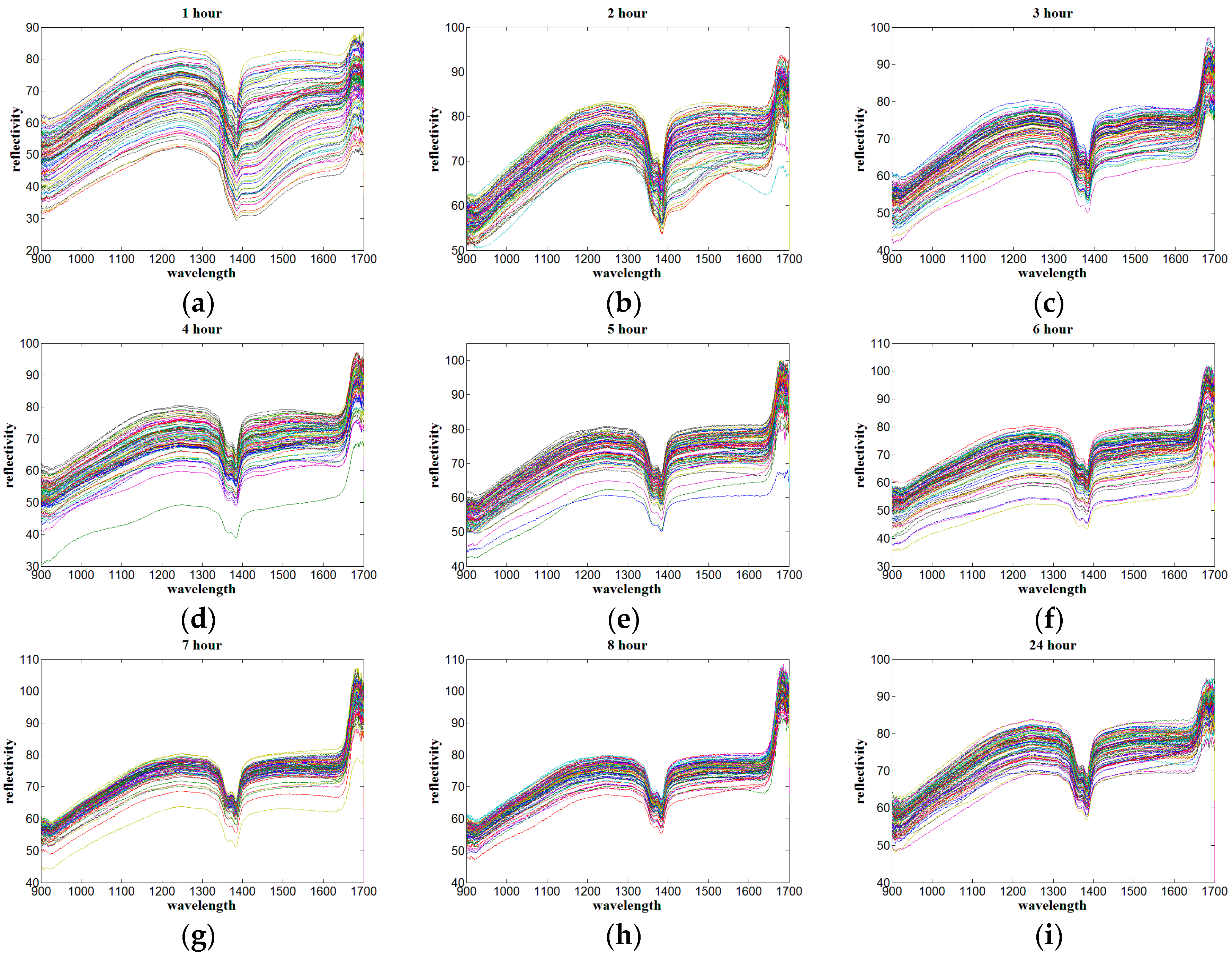
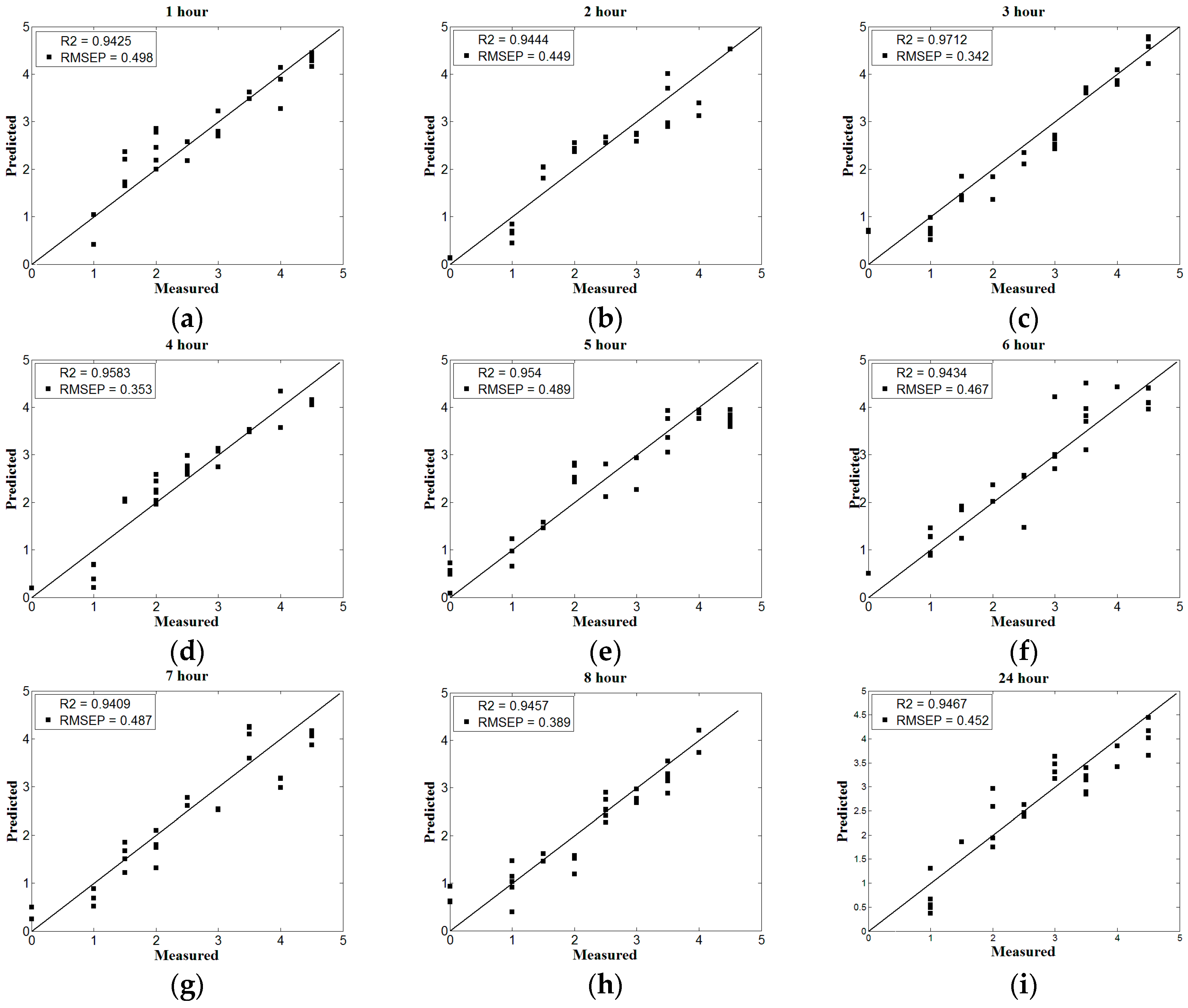
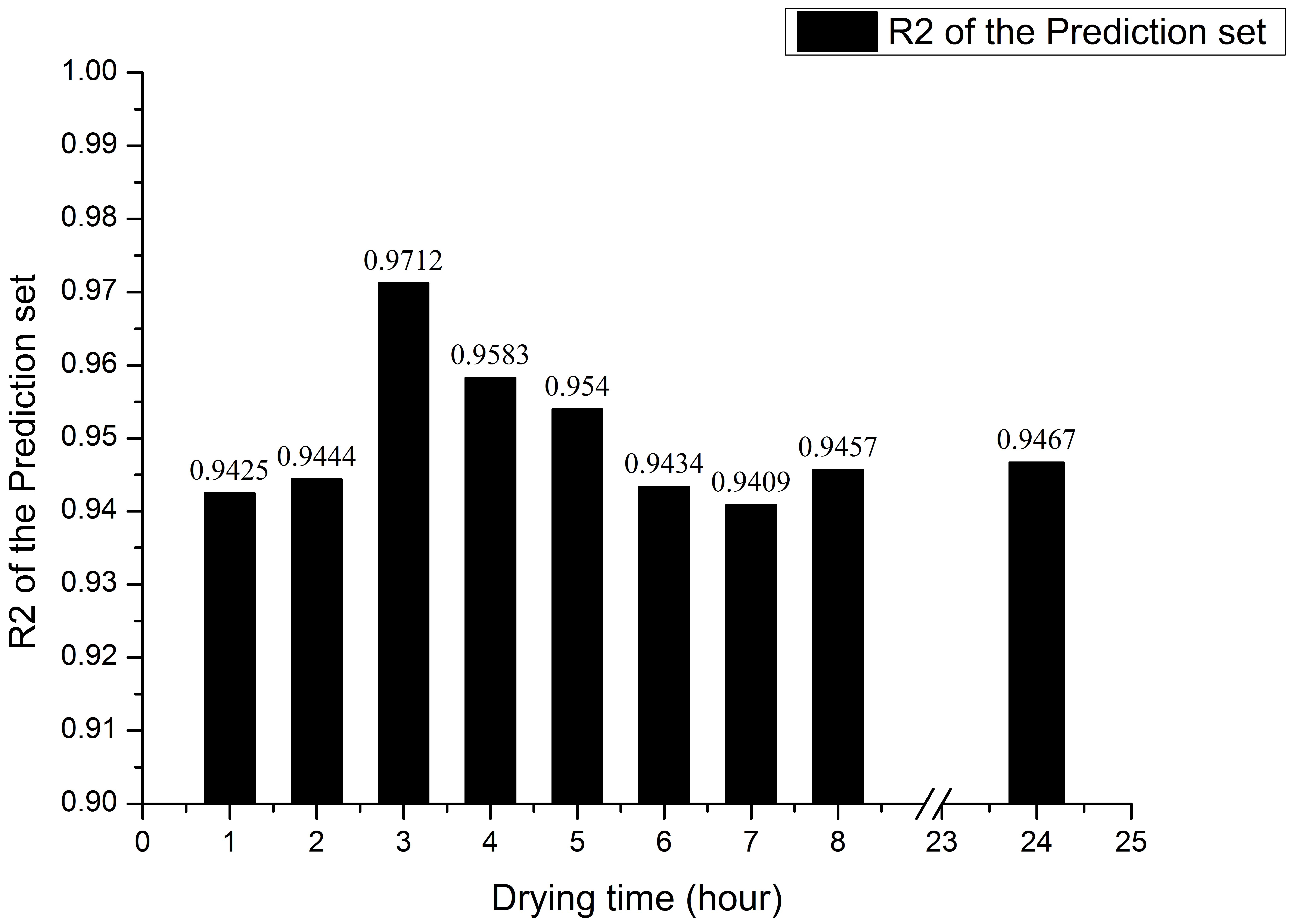
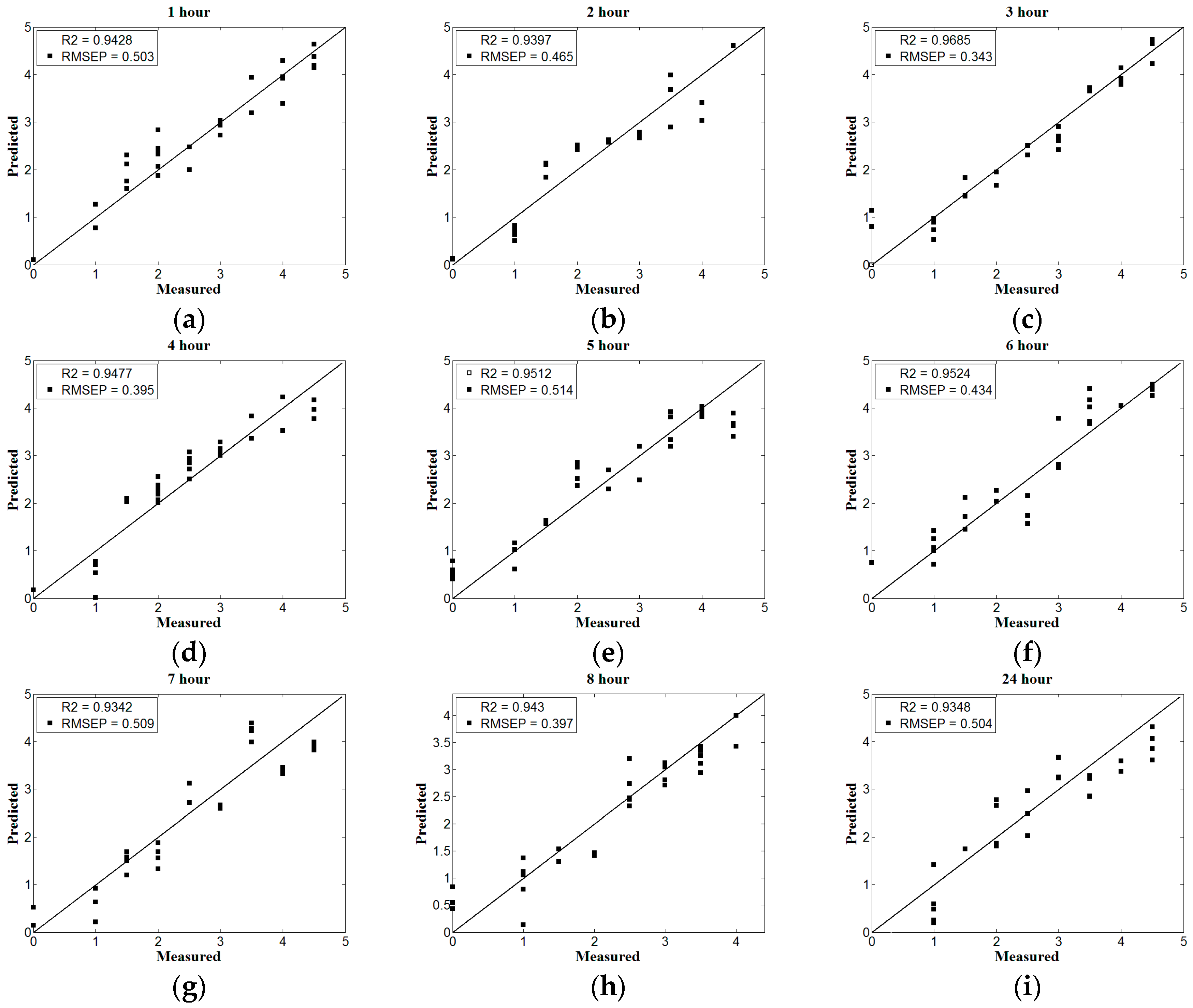
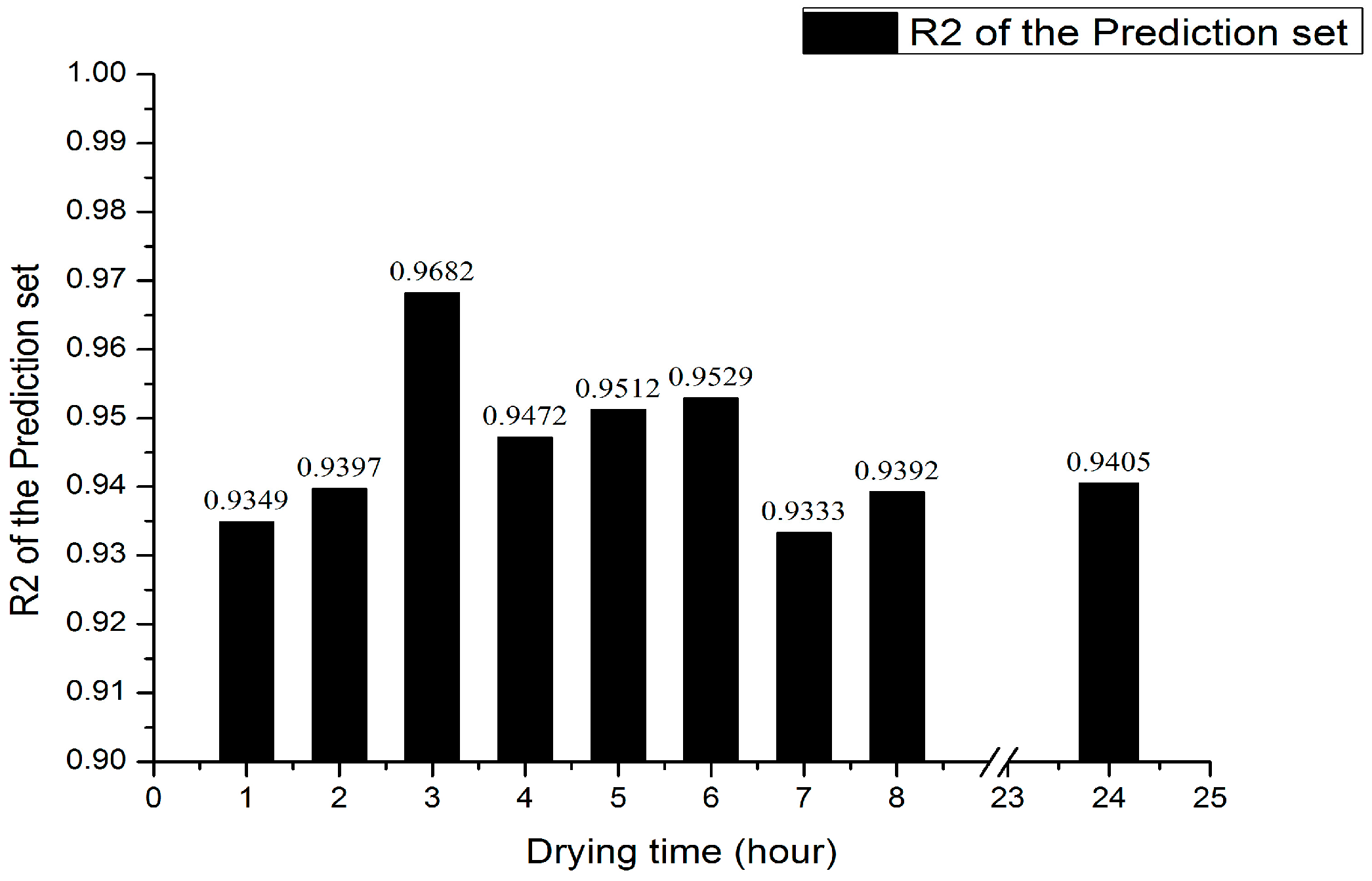
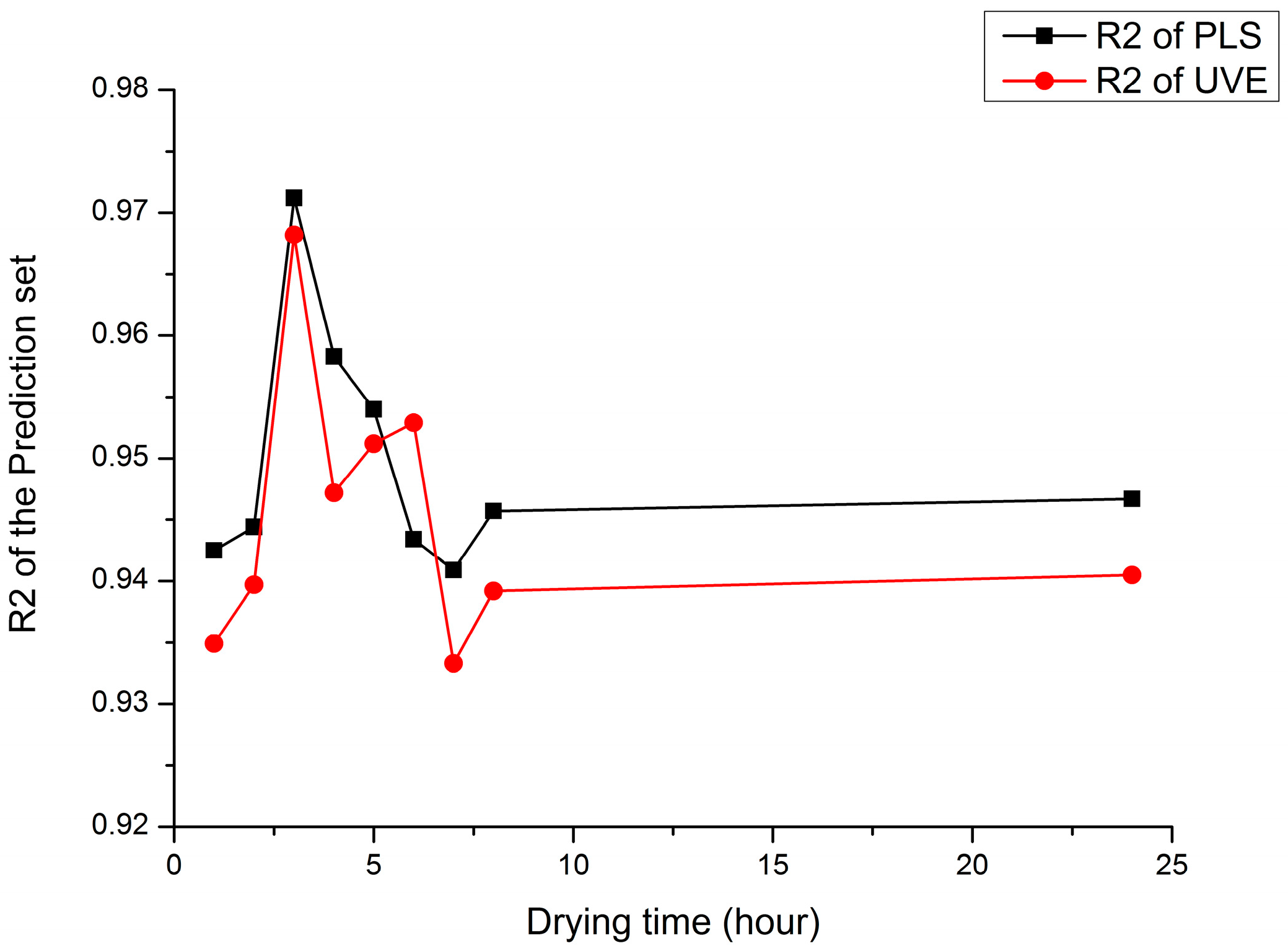
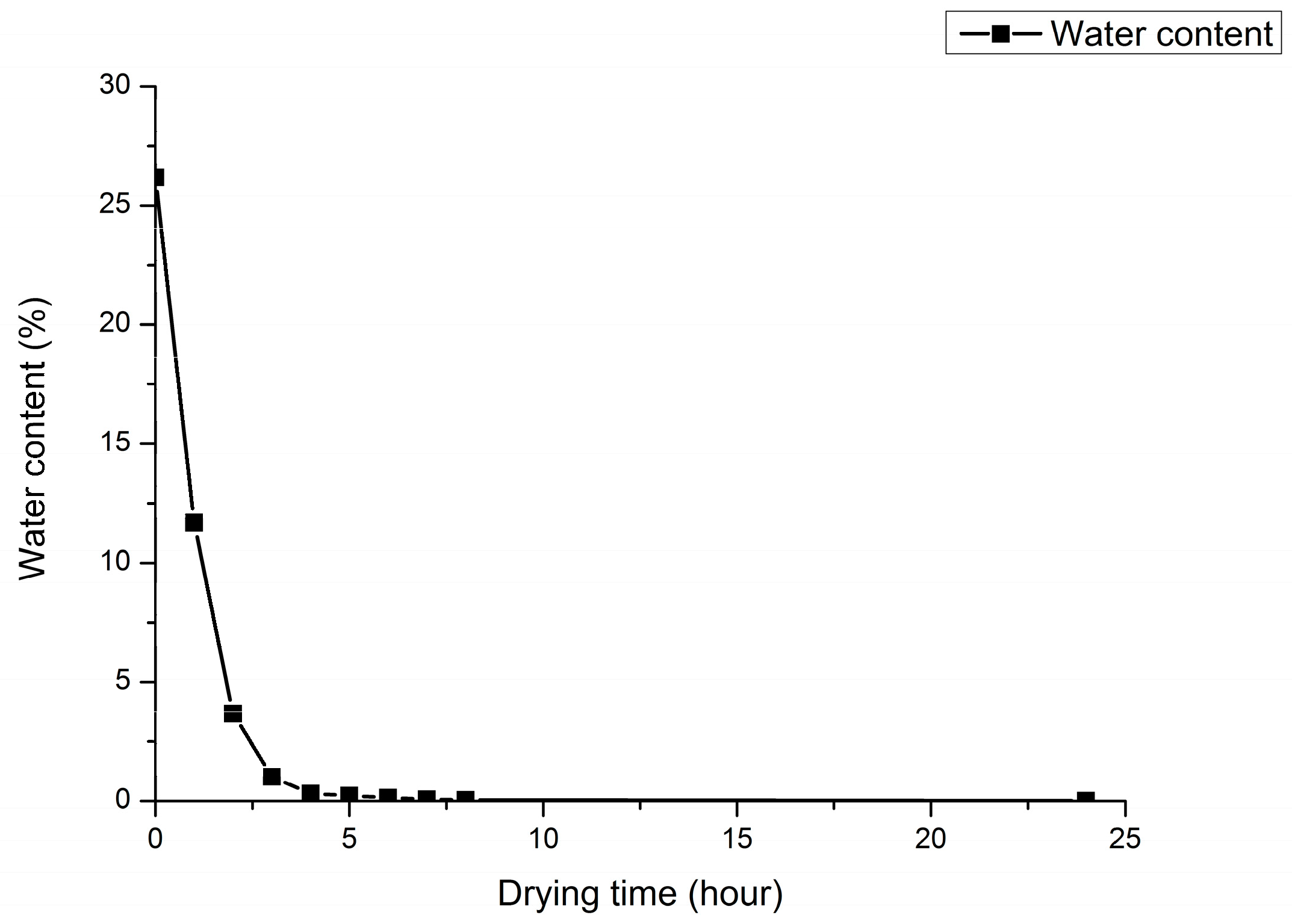
| Drying Time | Water Content | Methods | R1 of the Calibration Set | R2 of the Prediction Set | Calibration Set RMSEC | Prediction Set RMSEP |
|---|---|---|---|---|---|---|
| 1 h | 11.67% | PLS | 0.9649 | 0.9425 | 0.3646 | 0.498 |
| UVE | 0.9803 | 0.9349 | 0.2743 | 0.528 | ||
| 2 h | 3.67% | PLS | 0.9554 | 0.9444 | 0.4107 | 0.449 |
| UVE | 0.958 | 0.9397 | 0.3991 | 0.465 | ||
| 3 h | 1.03% | PLS | 0.9721 | 0.9712 | 0.3235 | 0.342 |
| UVE | 0.9656 | 0.9682 | 0.3584 | 0.344 | ||
| 4 h | 0.32% | PLS | 0.971 | 0.9583 | 0.3491 | 0.353 |
| UVE | 0.96 | 0.9472 | 0.4088 | 0.397 | ||
| 5 h | 0.23% | PLS | 0.9338 | 0.954 | 0.4694 | 0.489 |
| UVE | 0.9266 | 0.9512 | 0.4936 | 0.514 | ||
| 6 h | 0.14% | PLS | 0.9939 | 0.9434 | 0.1534 | 0.467 |
| UVE | 0.9635 | 0.9529 | 0.3725 | 0.433 | ||
| 7 h | 0.07% | PLS | 0.9301 | 0.9409 | 0.5084 | 0.487 |
| UVE | 0.9431 | 0.9333 | 0.4604 | 0.508 | ||
| 8 h | 0.04% | PLS | 0.9706 | 0.9457 | 0.3551 | 0.389 |
| UVE | 0.9652 | 0.9392 | 0.3835 | 0.42 | ||
| 24 h | 0.01% | PLS | 0.9436 | 0.9467 | 0.467 | 0.452 |
| UVE | 0.946 | 0.9405 | 0.4571 | 0.48 |
© 2017 by the authors. Licensee MDPI, Basel, Switzerland. This article is an open access article distributed under the terms and conditions of the Creative Commons Attribution (CC BY) license (http://creativecommons.org/licenses/by/4.0/).
Share and Cite
He, Y.; Xiao, S.; Nie, P.; Dong, T.; Qu, F.; Lin, L. Research on the Optimum Water Content of Detecting Soil Nitrogen Using Near Infrared Sensor. Sensors 2017, 17, 2045. https://doi.org/10.3390/s17092045
He Y, Xiao S, Nie P, Dong T, Qu F, Lin L. Research on the Optimum Water Content of Detecting Soil Nitrogen Using Near Infrared Sensor. Sensors. 2017; 17(9):2045. https://doi.org/10.3390/s17092045
Chicago/Turabian StyleHe, Yong, Shupei Xiao, Pengcheng Nie, Tao Dong, Fangfang Qu, and Lei Lin. 2017. "Research on the Optimum Water Content of Detecting Soil Nitrogen Using Near Infrared Sensor" Sensors 17, no. 9: 2045. https://doi.org/10.3390/s17092045






